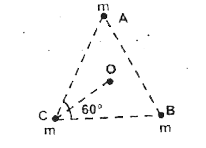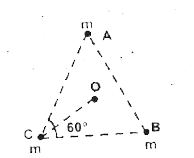Three particles, each of the mass m are situated at the vertices of an equilateral triangle of side a. The only forces acting on the particles are their mutual gravitational forces. It is desired that each particle moves in a circle while maintaining the original mutual separation a. Find the initial velocity that should be given to each particle and also the time period of the circular motion. (F=Gm1m2r2)
2π√a13Gm
2π√a23Gm
2π√a32Gm
2π√a33Gm
The correct Answer is:D
To solve the problem, we need to find the initial velocity that should be given to each particle so that they move in a circular path while maintaining the original mutual separation a. We will also find the time period of this circular motion.
Step 1: Understanding the Configuration
We have three particles of mass m located at the vertices of an equilateral triangle with side length a. Each particle experiences gravitational forces due to the other two particles.
Step 2: Gravitational Force Calculation
The gravitational force \( F \) between any two particles is given by the formula:
\(
F = \frac{G m^2}{a^2}
\)
where \( G \) is the gravitational constant.
Step 3: Net Force Calculation
Since each particle is acted upon by the gravitational forces from the other two particles, we need to find the net force acting on one particle. The angle between the forces due to the two other particles is \( 60^\circ \).
Using the law of cosines, the net force \( F_{\text{net}} \) can be calculated as:
\(
F_{\text{net}} = \sqrt{F^2 + F^2 + 2F \cdot F \cdot \cos(60^\circ)} = \sqrt{F^2 + F^2 + F^2} = \sqrt{3F^2} = \sqrt{3}F
\)
Substituting the value of \( F \):
\(
F_{\text{net}} = \sqrt{3} \cdot \frac{G m^2}{a^2} = \frac{\sqrt{3} G m^2}{a^2}
\)
Step 4: Centripetal Force Requirement
For the particles to move in a circular path, the net gravitational force must provide the necessary centripetal force. The centripetal force \( F_c \) required for circular motion is given by:
\(
F_c = \frac{m v^2}{r}
\)
where \( v \) is the velocity of the particles and \( r \) is the radius of the circular path.
Step 5: Finding the Radius
The radius \( r \) of the circular motion can be determined from the geometry of the equilateral triangle. The distance from the center of the triangle to a vertex is given by:
\(
r = \frac{a}{\sqrt{3}}
\)
Step 6: Equating Forces
Setting the net gravitational force equal to the centripetal force:
\(
\frac{\sqrt{3} G m^2}{a^2} = \frac{m v^2}{\frac{a}{\sqrt{3}}}
\)
Simplifying this equation:
\(
\frac{\sqrt{3} G m^2}{a^2} = \frac{m v^2 \sqrt{3}}{a}
\)
Cancelling \( m \) from both sides and rearranging gives:
\(
v^2 = \frac{G m}{a}
\)
Thus, the initial velocity \( v \) is:
\(
v = \sqrt{\frac{G m}{a}}
\)
Step 7: Time Period Calculation
The time period \( T \) of the circular motion can be calculated using the formula:
\(
T = \frac{\text{Circumference}}{\text{Velocity}} = \frac{2 \pi r}{v}
\)
Substituting the values of \( r \) and \( v \):
\(
T = \frac{2 \pi \left(\frac{a}{\sqrt{3}}\right)}{\sqrt{\frac{G m}{a}}}
\)
This simplifies to:
\(
T = 2 \pi \frac{a}{\sqrt{3}} \cdot \sqrt{\frac{a}{G m}} = 2 \pi \sqrt{\frac{a^3}{3 G m}}
\)
Final Answers
- The initial velocity \( v \) that should be given to each particle is:
\(
v = \sqrt{\frac{G m}{a}}
\)
- The time period \( T \) of the circular motion is:
\(
T = 2 \pi \sqrt{\frac{a^3}{3 G m}}
\)
We have three particles of mass m located at the vertices of an equilateral triangle with side length a. Each particle experiences gravitational forces due to the other two particles.
The gravitational force \( F \) between any two particles is given by the formula:
\(
F = \frac{G m^2}{a^2}
\)
where \( G \) is the gravitational constant.
Since each particle is acted upon by the gravitational forces from the other two particles, we need to find the net force acting on one particle. The angle between the forces due to the two other particles is \( 60^\circ \).
\(
F_{\text{net}} = \sqrt{F^2 + F^2 + 2F \cdot F \cdot \cos(60^\circ)} = \sqrt{F^2 + F^2 + F^2} = \sqrt{3F^2} = \sqrt{3}F
\)
Substituting the value of \( F \):
\(
F_{\text{net}} = \sqrt{3} \cdot \frac{G m^2}{a^2} = \frac{\sqrt{3} G m^2}{a^2}
\)
For the particles to move in a circular path, the net gravitational force must provide the necessary centripetal force. The centripetal force \( F_c \) required for circular motion is given by:
\(
F_c = \frac{m v^2}{r}
\)
where \( v \) is the velocity of the particles and \( r \) is the radius of the circular path.
The radius \( r \) of the circular motion can be determined from the geometry of the equilateral triangle. The distance from the center of the triangle to a vertex is given by:
\(
r = \frac{a}{\sqrt{3}}
\)
Setting the net gravitational force equal to the centripetal force:
\(
\frac{\sqrt{3} G m^2}{a^2} = \frac{m v^2}{\frac{a}{\sqrt{3}}}
\)
Simplifying this equation:
\(
\frac{\sqrt{3} G m^2}{a^2} = \frac{m v^2 \sqrt{3}}{a}
\)
Cancelling \( m \) from both sides and rearranging gives:
\(
v^2 = \frac{G m}{a}
\)
Thus, the initial velocity \( v \) is:
\(
v = \sqrt{\frac{G m}{a}}
\)
The time period \( T \) of the circular motion can be calculated using the formula:
\(
T = \frac{\text{Circumference}}{\text{Velocity}} = \frac{2 \pi r}{v}
\)
Substituting the values of \( r \) and \( v \):
\(
T = \frac{2 \pi \left(\frac{a}{\sqrt{3}}\right)}{\sqrt{\frac{G m}{a}}}
\)
This simplifies to:
\(
T = 2 \pi \frac{a}{\sqrt{3}} \cdot \sqrt{\frac{a}{G m}} = 2 \pi \sqrt{\frac{a^3}{3 G m}}
\)
- The initial velocity \( v \) that should be given to each particle is:
\(
v = \sqrt{\frac{G m}{a}}
\)
- The time period \( T \) of the circular motion is:
\(
T = 2 \pi \sqrt{\frac{a^3}{3 G m}}
\)
Topper's Solved these Questions
- BOOK - DC PANDEYCHAPTER - CIRCULAR MOTIONEXERCISE - Solved Examples2videos
CIRCULAR MOTION
- BOOK - DC PANDEYCHAPTER - CIRCULAR MOTIONEXERCISE - Miscellaneous Examples5videos
CIRCULAR MOTION
- BOOK - DC PANDEYCHAPTER - CENTRE OF MASS, LINEAR MOMENTUM AND COLLISIONEXERCISE - Level 2 Subjective21videos
CENTRE OF MASS, LINEAR MOMENTUM AND COLLISION
- BOOK - DC PANDEYCHAPTER - COMMUNICATION SYSTEMEXERCISE - Only One Option is Correct27videos
COMMUNICATION SYSTEM
Similar Questions
Three parties, each of mass m, are situated at the vertices of an equilateral triangle of side length a . The only forces acting on the pariclaes are th eir mutual gravitational forces. It is desired that each particles moves ina a circle while maintaining the original mutual separation a. Find the initial velocity that should be given to each particle and also the time period of teh circular motion.
View SolutionThree particles, each of mass m, are situated at the situated at the vertices of an equilateral triangle of side 'a'. The only forces acting on the particles are their mutual gravitational forces. It is intended that each particle moves along a circle while maintaining their original separation 'a'. Determine the initial velocity that should be given to each particle and the time period of the circular motion. The resultant force on particle at A due to other two particles is
View Solution
Knowledge Check
- Question 1 - Select One
Three particles each of mass m are kept at vertices of an equilateral triangle of side L. The gravitational field at centre due to these particle is
AzeroB3GML2C9GML2D12GM√3L2 - Question 2 - Select One
Three particles each of mass m are kept at the vertices of an euilateral triangle of side L. The gravitational field at the centre due to these particle is
AzeroB3GML2C9GML2D2GML2 - Question 3 - Select One
Three particles of equal mass 'm' are situated at the vertices of an equilateral triangle of side L. The work done in increasing the side of the triangle to 2L is
A2G2m2LBGm22LC3Gm22LD3Gm2L
Three particles, each of mass m, are situated at the vertices of equilateral triangle of side length a. The only forces. It is desired that each particle moves in a circle while maintaining the original mutual speration a. Find the intial velocity that should be given to each particle and also the time period of the circular motion.
View SolutionThree particles, each of mass m are fixed at the vertices of an equilateral triangle of side length a. The only forces acting on the particles are their mutual gravitational forces. Then answer the following questions.

The gravitational potential at O isView SolutionThree particles, each of mass m are fixed at the vertices of an equilateral triangle of side length a. The only forces acting on the particles are their mutual gravitational forces. Then answer the following questions.

Force acting on particle C, due to particle A and BView SolutionThree particles each of mass m are palced at the corners of an equilateral triangle of side b. The gravitational potential energy of the system of particle is
View SolutionThree particles each of mass m are kept at the vertices of an euilateral triangle of side L. The gravitational field at the centre due to these particle is
View Solution

